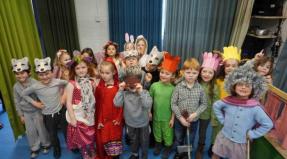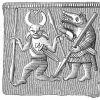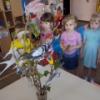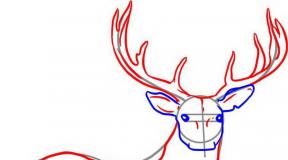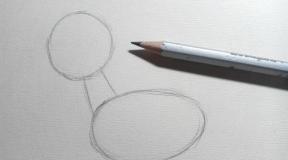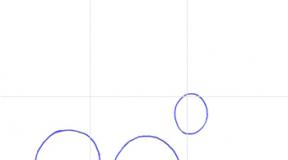The image of emotions on the face. Psychoesthetics of the face: how a person's emotions affect his appearance. The muscles of the face are relaxed, the lips are relaxed, the mouth is open, the eyes are open wide: surprise
Fragment of the book P. Ekman, W. Friesen. Recognize a liar by their facial expressions. St. Petersburg: Peter, 2010.
The new book by Paul Ekman can be called the second volume of the acclaimed bestseller "The Psychology of Lies". It is filled with a huge number of carefully selected photographs and special exercises.
Science knows hundreds of experiments devoted to the study of the expression of emotions on the face. In our previous books, we analyzed these studies in detail, but here we will briefly describe only those that are directly related to the topic of this publication. The information provided in this chapter should help to resolve doubts of skeptics about the scientific basis of what is said and what is shown in the following chapters. This chapter is also intended for those who are interested in ways to study facial expressions.
What emotions are really reflected on the face?
Does the face only say that the person feels something pleasant or unpleasant, or does it provide more accurate information - for example, what unpleasant emotion the person is experiencing? If the latter is true, then how many of these specific emotions does the face show - six, eight, twelve, or more? A typical method used to determine which emotions can be read on a face is by showing photographs of different facial expressions to observers, who are asked to say what emotion they see in each photograph. Observers can be given a predefined list of emotion words from which they make their choice, or they can choose any words that come to mind to designate emotions. The researcher analyzes the responses of different observers to determine the emotions on certain faces about which the observers agree. A researcher might, for example, find that 80% of observers used the word "frightened" to describe a particular person. There may be less consensus regarding the choice of word to describe another person; for example, a face described by half of the observers as “indifferent” may be described by other observers as expressing other emotions. Based on these results, the researcher makes a conclusion about what emotions a face can convey.
The six emotions discussed in this book — joy, sadness, surprise, fear, anger, and disgust — have been found in the past thirty years by every researcher who has attempted to compile a vocabulary for emotions associated with different facial expressions. There are other emotions displayed on the face, such as shame and arousal, but they have not been thoroughly researched yet. Since we will show how not only these six emotions are manifested on the face, but also thirty-three different combinations of them, then in our book a fairly large part of the spectrum of expression of emotions on the human face will be presented.
How accurate are judgments about emotions?
Determining what emotions are expressed on a given face is not enough. It is also important to find out whether the observers' interpretations are correct or not. When people look at someone's face and decide that that person is scared, are they right or not? Are facial expressions accurate reflections of emotional experiences? Are the impressions of facial expressions the usual stereotypes - unanimously chosen but not always correct? To explore these questions, the researcher needs to find a few people who he knows have specific emotional experiences. He should take photographs or videos of images of these people and show them to observers. If observers' judgments about facial expressions are consistent with the researcher's knowledge of the emotional experience of the assessed individual, then the accuracy of the assessment is beyond doubt.
Most studies on the accuracy of evaluating facial expressions have somehow failed to provide conclusive evidence of the validity of the results obtained, usually because the researcher's knowledge of the emotional experience of the people being assessed was imperfect. In our analysis of experiments over the past fifty years, we have indeed found logical and irrefutable evidence that it is possible to obtain accurate estimates of facial expressions. Some of these studies were carried out directly in our laboratory. In one experiment, photographs were taken of people with mental illness as they were admitted to a psychiatric hospital, and then again when they were calm and preparing to be discharged. These photographs were shown to untrained observers and asked when the photographs of each facial expression were taken - at admission to hospital or at discharge. The estimates were accurate. The same photographs were then shown to another group of observers, unannounced that they were seeing pictures of psychiatric patients, and asked these people to rate whether the patients' emotions were pleasant or unpleasant. Once again, we were able to obtain accurate assessments because the facial expressions of the patients upon admission to the hospital were found to be more unpleasant than those of the same individuals upon discharge. In a further study, other observers were asked to rate how pleasant or unpleasant the facial expressions were, but the faces they showed were those of psychiatrists who were interviewed under emotional stress. Not knowing who was who, the observers rated the facial expressions during the stressful period as more unpleasant than the expressions of the faces photographed during the non-stress phase of the interview. In a completely different experiment, observers were shown two films about college students. One movie was filmed while the students were watching an unpleasant movie about surgery, and the other was filmed while they were watching a pleasant movie about travel. Observers were able to pinpoint the exact film they were watching from the students' expressions.
All of these studies have been devoted to the study of spontaneous facial expressions that occur naturally when a person does not intentionally try to show some kind of emotion on his face. But what can you say about those situations in which a person deliberately tries to portray some kind of emotion on his face in order to look joyful, angry, etc.? Many studies have noted that observers can pinpoint exactly what emotion was meant when a person deliberately tried to convey the emotion through their facial expressions.
Are there universal expressions of emotion on your face?
Are facial expressions the same for all people, regardless of their origin? When a person is angry, will we see this expression on their face regardless of the person's race, culture or language? Or are facial expressions a special language that we have to learn again in every culture, how do we have to learn spoken language? Just over a hundred years ago, Charles Darwin wrote that facial expressions are universal and not learned differently in different cultures; that they are biologically determined and are the result of human evolution. Since Darwin's time, many authors have strongly disagreed with this statement. More recently, however, the results of scientific research have finally resolved this issue, showing that facial expressions of at least a few emotions (namely those discussed in this book) are certainly universal, although some cultural differences can be noticed when they are considered.
Research carried out in our laboratory has played a critical role in resolving the debate over whether facial expressions are universal or culturally specific. In one experiment, a stressful film was shown to American and Japanese students. Part of the time each student watched the film alone, and part of the time they talked about their experiences to the research assistant, who belonged to the same culture as the student. Measurements of actual facial muscle movements captured on video showed that when students watched the film alone, Americans and Japanese had nearly identical facial expressions (Figure 1). However, in the presence of another person, when the cultural rules for controlling the face (display rules) began to operate, there was little correspondence between the facial expressions of Japanese and Americans. The Japanese masked the expressions of unpleasant feelings on their faces to a greater extent than the Americans. This research was especially important in demonstrating what is universal in facial expressions and what is specific to each culture. A universal characteristic is a specific facial appearance for each of the basic emotions. But different cultures have different ideas about how to manage and control facial expressions.
Rice. one. An example of the spontaneous facial expressions of a Japanese (left) and an American (right) when watching a stressful movie

In another experiment, we showed photographs of faces with different expressions of emotion to observers in the United States, Japan, Chile, Argentina, and Brazil. Observers from these different cultures were required to select one word describing one of six basic emotions for each of the photographs they were shown. If facial expressions were a special language, different in different cultures, then the facial expression called by the Americans angry, might be called surprised or frightened by Brazilians, or might mean nothing to them at all. However, the results obtained were completely opposite. The same facial expressions were qualified as reflecting the same emotions by representatives of all these countries, regardless of their language and culture (Fig. 2). In fact, the same experiment was carried out at the same time independently by Carol Izard, with the involvement of observers from eight different cultures, and produced results that also support the assumption of the universality of facial expressions.
While we wanted to interpret our results as evidence that some facial expressions are universal, there was one weakness in our experiment. All the people we surveyed had some kind of common visual contact, usually not directly, but through the mass media. It is possible that typical facial expressions may in fact differ across all cultures surveyed, but through films, television, and illustrated magazines, people have been able to learn what expressions of emotion look like on other people's faces. Or facial expressions may have been the same across all cultures we surveyed precisely because all people learned how to express emotions on their faces by seeing the same actors in movies or TV shows and imitating their facial expressions. We have not eliminated the possibility that among people who did not have the opportunity to see how emotions are expressed on the faces of film and television stars, emotions would begin to manifest themselves using completely different movements of the facial muscles. The only way to deal with this problem was to examine visually isolated people who had no contact with the media and had minimal contact with the outside world.
Percentage of the same photo ratings in each of the cultures
Rice. 2... Examples of photographs used in a study of how emotions are assessed by educated people from different cultures
| USA (J = 99) | Brazil (J = 40) | Chile (J = 119) | Argentina (J = 168) | Japan (J = 29) | |
| Fear | 85% | 67% | 60% | 54% | 65% |
| Disgust | 92% | 97% | 92% | 92% | 90% |
| Joy | 97% | 95% | 95% | 98% | 100% |
| Anger | 67% | 90% | 94% | 90% | 90% |
We conducted a series of experiments in the highlands of southeastern New Guinea, where we could find people who met our criteria. Since these people never passed psychological tests and did not participate in experiments, and also because we did not know their language and worked through translators, we were forced to modify the procedure for conducting the experiment. In other countries, we simply showed a photograph of one or another expression of emotion and gave the observer the opportunity to choose the name of the emotion from a ready-made list. In New Guinea, we showed the observer three photographs at once, and the translator read a fictional story associated with this emotion (for example: "This man's mother died") and asked the observer to show a photograph corresponding to this story. We found that all of these people chose the same face for the same emotion, as did people in all the other cultures we surveyed. There was one exception: New Guineans did not distinguish between fear and surprise on their faces.
In a similar experiment, other Guineans were told a story associated with an emotion and asked each of them to show how the emotion was expressed on their faces. We have made videos of these deliberate expressions of emotion, four examples of which are shown in Fig. 3. Analysis again showed that the same facial expressions were used to display the same emotions, which was consistent with the results obtained in other cultures, with the exception of fear and surprise, emotions that Guineans constantly confused. Further evidence for the versatility of facial expressions came from research conducted in another culture in western New Guinea. Karl and Eleanor Haider, skeptical of our evidence for the universality of emotion expression, conducted the same experiments with people who were even more visually isolated from the world than those we surveyed, and also received confirmation of universality.
As a result, our research, the research of Isard, the research of the Haider spouses and the results obtained by Able-Eibesfeldt (an ethnologist who used completely different methods) convincingly showed Darwin's correctness in the question of the existence of universal expressions of emotion on the face.
Figure 3. Video footage taken during our attempts to capture the emotions of the people of New Guinea. Each photo had its own "legend": top left - "Your friend has come to you and you are glad to see him"; upper right - "Your child is dead"; lower left - "You are angry and ready to fight"; bottom right - "You see a dead pig that has been here for many days."

Although the facial appearance for each major emotion is common to all people, direct facial expressions can vary from culture to culture in at least two ways. That which in itself evokes emotion usually turns out to be different; in different cultures, people may experience disgust or fear in response to different stimuli. In addition, cultures differ in the conventions that people try to comply with when trying to control or manipulate their facial appearance in specific social situations. People in two different cultures may feel sadness over the death of a loved one, but one culture may dictate that the main participants in the funeral mask their sadness with expressions of mild joy on their faces.
How does each emotion appear on your face?
We started looking for evidence of universal facial expressions, and before all our research was complete, we began to figure out what these universal expressions looked like. We tried to compile an "Atlas" of the face, which, using photographs, would reflect each of the universal expressions of emotion. It is this Atlas that provides the scientific basis for explaining the photographs shown in subsequent chapters of this book. Our first step in the Atlas of Facial Expressions was to study what others had to say about facial appearance for each of the major emotions. Some authors described which muscles contracted when displaying certain emotions, while others focused only on the appearance of the face. But no one has systematically studied all the muscles or all the subsequent changes in the appearance of the face when displaying the six basic emotions.
Summarizing everything that was described by Darwin, Duchenne, Huber, Pluchik, we saw part of the emerging picture. We have compiled a table listing all the muscles in the face and six emotions, and entered into it everything that these authors wrote about each of the muscles involved in the display of each of the emotions. However, there were many gaps in the table due to the complete lack of information about the work of specific muscles that ensure the display of specific emotions on our face. Working with Sylvanas Tomkins, we have been able to fill these gaps with information that our intercultural studies and our shared experiences have provided us.
In the next step, we photographed the models, who were instructed on how to move their facial muscles. We photographed separately three areas of the face that can move independently of the rest: eyebrows - forehead; eyes - eyelids and bridge of the nose; and the lower part of the face, including the cheeks, mouth, most of the nose, and chin. The completed Atlas contains photographs of these three different areas of the face, with each photograph displaying one of six emotions. It is easy to understand that for each emotion in the Atlas there is more than one photograph of at least one part of the face. For example, for surprise, there is one photograph of the eyebrows - forehead, one photograph of the eyes - eyelids - bridge of the nose, and four photographs of the lower part of the face.
The next obvious question was about the correctness of the Atlas itself. Can the six emotions — joy, sadness, anger, fear, disgust, and surprise — be compiled from the outward manifestations of the face listed in the Atlas? Does the outward expression of disgust shown in the Atlas always arise with the expression of fear, etc.? We ran four experiments to test it. In two experiments, we tried to prove validity by demonstrating that the Atlas measurements of the face were consistent with other evidence of the subjective emotional experience of the individuals whose faces we measured. These experiments investigated the empirical validity of the Atlas.
Two other experiments were devoted to the study of the social credibility of Atlas. Without trying to prove that the Atlas measurements are consistent with the experience of the individual, we ascertained whether the Atlas measurements can actually predict how observers think about a person's feelings when they look at their face. Although empirical and social validity should be correlated, a connection between the two is not required. We may not show other people (at least constantly) how we really feel. Thus, we needed to examine both empirical and social validity.
Empirical validity studies were based on material collected from one of the previously described cross-cultural studies of facial expressions. Students from the United States and Japan watched pleasant and unpleasant films alone, while their facial expressions were captured on video. From their responses to the questionnaire after the experiment, it became clear that they experienced very different emotions when watching the two films. When describing their reactions to the travel movie, they said it was interesting, enjoyable, and made them feel mild joy. When describing reactions to the surgical film, they reported feelings such as disgust, pain, fear, discouragement, and surprise. If the Atlas of Faces is reliable, then the measurements taken with it should show the difference between the facial expressions that appeared in students experiencing these two different sets of emotions.
All facial muscle movements on videotape were highlighted in a special way, their durations were measured, and they themselves were classified in terms used in the Atlas. This measurement was performed in slow motion, with measurements taken separately for three areas of the face by three technicians. Such an accurate measurement took about five hours of time per minute of videotaped facial changes. The results were crystal clear. Face Atlas measurements clearly showed the difference between two emotional states: the one that arises when watching a travel movie and that that arises when watching a stressful movie. In addition, the use of Atlas has been equally successful with the facial expressions of both Japanese and American students - as it should have been, because Atlas was created with the goal of showing universal expressions of emotion on the face. However, the disadvantage of the experiment was that it did not allow us to determine whether Atlas correctly displays the state of the face for each of the six emotions. The experiment only showed that Atlas makes it possible to distinguish between unpleasant and pleasant emotional experiences.
Our second study of empirical validity made it possible to partially overcome this deficiency. We used the results of one study in the psychology of emotions, which indicated that there are completely different patterns of accelerating and decelerating heartbeats for the emotions of surprise and disgust. Heart rate and skin conductance measurements were taken by us on American and Japanese students while watching two different films: enjoyable and stressful. If the Atlas correctly describes the faces of people experiencing surprise and disgust, then when the Atlas indicates that such expressions do arise, in each case different patterns of changes in the rhythm of the heartbeat should be observed. When examining patterns of changes in heart rate that matched the facial expressions that Atlas presented as being caused by either surprise or disgust, the results fully mirrored the predicted differences.
While the second study does point to evidence of the Atlas's validity for the emotions of surprise and disgust, it does not show that the Atlas necessarily holds true for other emotions: anger, joy, sadness, and fear. It would be logical to think that if the Atlas demonstrates its validity in relation to surprise and disgust, then it should be equally valid for other emotions, because it was compiled using the same method for all six emotions. But we needed real evidence, and so we conducted a third study of the Atlas - this time to assess its social credibility. Can Atlas predict how observers will interpret facial expressions?
We have collected photographs taken by various facial expression researchers. These photographs were then shown to observers who were asked to determine which of the six emotions represented in each of them. For further research, only those photographs were left in the assessment of which the observers showed complete unanimity. But if the Atlas correctly describes the external manifestations of each of the six emotions, then the measurements taken with its help should have predicted the emotions that observers saw in each of these photographs. Measurements with the help of the Atlas were carried out separately for each of the three parts of the face by three independent specialists, and on their basis the predictions we were interested in were made. It turned out that Atlas successfully predicted the emotions that observers saw in photographs of various human facial expressions.
The fourth study was very similar to one of the studies we described above, except that it analyzed the facial expressions of medical students who were asked to display six basic emotions on their faces. For each photograph, Atlas had to determine what emotion the student was going to express on his face. The measurements made with the help of Atlas made it possible to successfully solve this problem.
While we were conducting these experiments, independently of us, the Swedish anatomist Karl-Hermann Hjortsso, using completely different methods, worked on the same problem. He photographed his face as each of his facial muscles contracted. Hjortso then analyzed each of these photographs and determined what emotion was displayed on it. Then, based on his assessments, he described in his own atlas the facial expressions for each of the emotions. When we recently met with Hjortso, we found to our common delight that our atlases were almost identical.
How is facial expression controlled?
How can we distinguish a real expression of emotion on a face from a simulated one? When a person does not feel what he is portraying and tries to mislead us about his experiences? Is there a way to tell his real feelings from his facial expressions? In other words, is it possible to “leak information” from a person?
We have been dealing with this problem for many years. We started with video recordings of facial expressions of psychiatric patients taken during interviews. Occasionally, subsequent events indicated that patients misled the interviewer about their feelings. The study of these videos laid the foundation for the theory of non-verbal leaks information that allows you to judge by the expression on the face or body movements of a person about those feelings that he is trying to hide. We have tested this theory over the past years by examining interviews in which one person deliberately concealed from another the negative emotions they experienced while watching extremely unpleasant, stressful films. In this experiment, the subjects try to convince the interviewer that the movie they watched was very enjoyable and that they enjoyed it.
The study of these interviews, of course, cannot be considered complete; many of our hypotheses remain to be tested. However, the results to date are consistent with earlier findings from interviews with patients in psychiatric hospitals.
The Deceiving Facial Expressions chapter is based on researching our theory and analyzing the facial expressions of people trying to lie.
How are emotions experienced?
We ourselves did not study this issue ourselves, but when planning the compilation of this book, we thought that we would be able to use the results presented in the scientific literature. To our disappointment, we found that while there are many theories of emotion and research on emotion, some fundamental issues have not received sufficient attention. For example, what events trigger each emotion? What are the possible variations in the intensity of each emotion? How does each emotion feel different? What are the likely actions of people experiencing anger, disgust, fear, etc.?
There were some answers or ideas in the literature related to at least some of the emotions. The most useful were the works of Darwin and Tomkins. Much of what we wrote inevitably had to be an extrapolation of the results of our own experiments and years of reflection on the six emotions, the expressions of which we studied. In each of the chapters that follow, we talk about the experience of each emotion, what is known to science and what remains to be learned. Many of our friends and colleagues, after reading these chapters, have found that the facts presented in them agree well with what they have observed in their own lives and in the lives of people they know. You will be able to determine the value of this reasoning by comparing it with your personal experience and that of your friends. If anything that has been said here (for example, about anger) contradicts your experience or the experience of your friends, then we may be wrong. If this contradicts your experience, but makes sense for your friends, then you will find out how the specificity of the experience of this emotion is manifested personally by you (or your friends).
© P. Ekman. W. Friesen. Recognize a liar by their facial expressions. St. Petersburg: Peter, 2010.
© Published with permission of the publisher
We see millions of eyes, mouths, noses, ears and chins in this world, and each of them is special. At the same time, in order to draw cartoon faces, it is enough to know the basics. Once you master them, add to this an understanding of depth, then make sure that the drawing of the head looks three-dimensional (3D), and also master the technique of drawing from any angle. If you know how to do all this - great! However, if you really want to draw attention to your art, you'll have to master a technique that will bring characters to life with facial expressions!
Anyone can paint a face. Draw a circle, add a few points and lines - and anyone who looks at your drawing will say that this is a face. On the one hand, it seems to be so easy to do, but on the other, it can be very difficult when feelings and emotions appear ...
Human facial expressions
A person's facial expressions, as well as their tone of voice, are easy to change. Expressions appear on the face not only as a result of the contraction of certain muscles; in fact, some muscles contract at the same time, and the opposite muscles relax. For example, the same muscle groups are involved in both laughter and smiling, but with different intensities.
If I ask you to name exactly all the feelings that you see in the picture below, what would you say?
I know what you will answer. You will most likely say that you see an image of calmness and reflection. Perhaps he was thinking about something. In reality, it’s not like that! In this picture, we see a complete lack of emotion, since not a single muscle is involved. Since there is no emotion, perhaps the best description would be the words "calm" and "relaxed".
It is only natural to use this expression in your drawings. Why not? - 80% of people have this facial expression most of the day! However, people have such an expression only when they are alone. After all, when a person looks at another person, or when he finds himself in a certain situation, a reaction inevitably arises. And there will be a reaction to it! In animation, we inflate this effect to the maximum so that it is clear to our audience exactly which emotions are expressed on the face.
Primitive emotions
Primitive emotions are those emotions, the occurrence of which, we, human beings, are not particularly in control. This means that such an emotion is not easy to direct. Let's say it appears suddenly, in response to a primitive stimulus.
Primitive emotions are expressed regardless of our culture, nationality or age. Below are examples of the most basic ones:

- Joy (1): the corners of the mouth are raised up, the eyebrows are raised, the eyes are wide open.
- Anger (2): the corners of the mouth are lowered, the eyebrows are raised at an angle, and the inner edges are lowered, the eyes are wide open.
- Fear (3): the mouth is slightly skewed, the corners go down, the eyebrows are raised up, while the eyebrow line is uneven, the eyes are wide open.
- Sadness (4): the corners of the mouth are rounded downwards, the inner corners of the eyebrows are slightly raised, the upper eyelids "hang" over the eyes.
These are primitive facial expressions that quite often appear on our faces throughout our lives. To draw cartoon characters, you need to master these four expressions. Based on them, we can create all other emotions.
There are also a couple of expressions, they are less often referred to as primitive, while they are also included in the group of basic expressions.

- Surprise (5): the mouth is small, half open, the eyebrows are raised, the eyebrow line is slightly uneven, the eyes are wide open.
- Annoyance (6): the mouth is crooked, skewed, the eyebrows are lowered, the inner tips of the eyebrows are directed downward, the eyes are closed.
"Why on earth are you separating these two from the first group?"- The answer is simple: If you notice, each of these expressions is a combination of expressions from the first group.
Now that you are familiar with basic expressions, you are probably wondering why there are so few of them. It's simple: we have primary colors, and there are enough of them to mix any colors you want. Likewise, primitive emotions can be used to compose other facial expressions! Take a look:
To create a sleepy facial expression, we took the eyebrows from the expression joy and added to them half-closed eyes from sorrow... Great, isn't it?

Related emotions
That's not all! You can create related emotions, it is enough to take the most similar emotion and change only one element in the face, and one more emotion!

Note that only the mouth has been changed in these two figures. We can express two kinds of disgust by changing one single part of the face! (captions in the picture: "Damn!" and "Stink!") Below is another example:
 Let me remind you that it was enough for us to change the mouth to create the necessary emotion. (Captions on the picture: "amazed", "afraid".)
Let me remind you that it was enough for us to change the mouth to create the necessary emotion. (Captions on the picture: "amazed", "afraid".) This time we will slightly redraw the mouth and eyes to complement the version of the main emotion. (Captions on the picture: "amazed" "confused").

Emotions can be drawn based on more than just basic ones. You can draw the third level of emotions based on the minor ones. Take a look:
 As before, it was only necessary to redraw the mouth. (Captions: "sleepy", "in love").
As before, it was only necessary to redraw the mouth. (Captions: "sleepy", "in love"). Awesome, right? With this technique, your designs can be brought to life with dozens, maybe hundreds, of emotional faces!
Emotions expressing physical condition
Emotions based on physical condition rely on the same concept of basic emotions, but they differ in that they can take various unpredictable forms.
 Note that physical emotions are also drawn based on primitive emotions. Fatigue taken from sorrow.
Note that physical emotions are also drawn based on primitive emotions. Fatigue taken from sorrow. Emotion can be expressed using an additional element, such as drops of sweat (Signature: "heat"):

Let's look at another example of a spontaneous response that we don't really know how to control. This time our character got electrocuted! In short, he has no control over his reaction!

When we are in shock, it is difficult to control, which gives us an advantage in drawing cartoon characters - you can exaggerate this expression as much as possible and achieve the desired effect. In this case, we have significantly enlarged the mouth.
Note that primitive emotions always dominate. Shock, even in its uncontrollable form, is nothing more than fear... As for the emotions of a physical state, it is interesting that in real life we express them without really thinking about how they arise, since we are subject to external factors and other conditions.
The power of emotions and additional elements
Cartoon facial expressions can also change depending on the strength of the expression. By varying the intensity, we achieve very interesting results:

 Vegeta? (If you're not in the know, this is a Dragon Ball character.) (Captions under the pictures: "shock", "huge shock!")
Vegeta? (If you're not in the know, this is a Dragon Ball character.) (Captions under the pictures: "shock", "huge shock!") In addition to intensity, you can add additional elements to enhance the effect. In the first image, we have added a few beads of sweat flying off the face to emphasize the expression of fear. In the second, they stick out their tongue to enhance the desired effect.

Returning to fear, let's see how to draw a stronger feeling - panic!
 We increased the size of the eyes and "made" the character cover his face - the result is an amazing effect! "Congratulations! (Caption under the picture:" scared to death ").
We increased the size of the eyes and "made" the character cover his face - the result is an amazing effect! "Congratulations! (Caption under the picture:" scared to death "). Change of perspective
You can change your perspective to make your facial expression more profound and to achieve a more dramatic effect. That is, change from what point you look at the scene: you can create unusual situations. If you position the point of view from an unfamiliar side, you will place your character in an “awkward” position. This will give the scene more dynamics.
 Here's an example of how changing perspective affects the strength of expression.
Here's an example of how changing perspective affects the strength of expression. Notice that when looking from top to bottom, the effect of humiliation of the character is automatically created, we kind of "force" him to shrink, he looks more fragile compared to the threat. In contrast, when viewed from the bottom up, the character looks more formidable. A protruding chin, a grin and a wild look create the perfect atmosphere for intimidation!
In animation, bad characters often have large lower jaws and small eyes. In this case, the weaker character will have large eyes and a more expressive, but small lower jaw, and the mouth is usually located below the chin. Try this technique in your designs to see for yourself!
Playing with common stereotypes and context
To create a stereotypical character, you can add minor elements that complement the context of the scene. Some of these methods can have an immediate effect, as we are used to holding stereotyped information throughout our lives. This is influenced by many factors, in particular: cinema, television and certain people from everyday life.
Take a drunkard, for example. Tangled hair, unshaven, heavy eyelids, missing teeth - and we have before us a classic drunken slob. We grow up and get used to the fact that such traits distinguish a person who abuses alcohol for a long time. The sick person is depicted as older, he has a swollen nose. Closed eyes and droplets of saliva indicate that something is wrong with his health.

Here's another example. The picture below suits different contexts. On the one hand, the person above may experience severe pain, while the person below is torn apart by rage.

Let's add a few details to make a big difference. See what happened? It was enough to add tears and a handkerchief, and it becomes obvious that both are crying.
 Additional elements change the context of the scene.
Additional elements change the context of the scene. Signal exchange
If we add to all of the above the numerous ways in which we exchange specific signals with other people, our face prepares many surprises for us. This is because, like physical states, we do not have much power over such "signs". Because of this, we sometimes react completely unexpectedly for ourselves, often succumbing to the will of the senses.
Below is an example of "signaling". Lovelace fixed a fatal gaze on the girl in order to achieve her with his magic of seduction. She responds with a look filled with passion. Do you think she fell in love with him?

Let's look at another example. The picture below is pretty typical in animation: a pretty girl makes eyes, so she always gets what she wants, and at the same time looks very cute.
 Who can resist such a pretty face?
Who can resist such a pretty face? Let's change the context. We change the direction of gaze, and now she is already looking away from the character in front of her. Now she looks more timid. Great, isn't it?
 In addition to the new direction of gaze, we added a little blush to the cheeks, and now we have a completely shy girl in front of us.
In addition to the new direction of gaze, we added a little blush to the cheeks, and now we have a completely shy girl in front of us. Conclusion
If you find it difficult to portray the feelings and emotions of your characters, one of the best ways to learn how to do this is to try it yourself. imitate these emotions. This will train your personal perception and add new techniques to your arsenal.
Expressing emotions and feelings in animation is a vast topic to explore and go far beyond facial expressions. As stated above, we are completely in control of our emotions until we lose control over them; for example, until a dog bites us.
Want to experiment? Invite your family to take a picture together and notice how they all smile the same way - this is a controlled emotion, we are able to express feigned joy if necessary. Now scare them well, and you will see how differently fear will appear on their face!
I hope you are now inspired and ready to try what you learned here - drawing different emotions on the faces of your characters. Remember that in animation we exaggerate most of these expressions; it is also important for you to understand at least the basics of how emotions are expressed on the face - this way you will help your viewer see what you want to convey.
 Well, who at least once has not used the power of seduction in an attempt to win someone's heart with a glance?
Well, who at least once has not used the power of seduction in an attempt to win someone's heart with a glance? Lisa Feldman Barrett has revolutionized the understanding of the brain and the management of feelings. She has done a tremendous job of scientifically researching emotions that are seemingly impossible to measure. Below are the results of some studies that prove that frowning is not always anger or annoyance, and smiling does not mean happiness or joy. In other words, each emotion does not have its own facial expression.
The same words
After earning my degree, becoming a professor at the university, I ran a laboratory that asked hundreds of subjects to track their emotional state over the weeks and months of their lives. My students and I looked at a wide range of emotions, not just experiences of anxiety and depression, to see if the finding was generalized.
These experiments established something never before documented: Everyone we tested used the same words, such as “angry,” “sad,” and “scared," to communicate their experiences, but they didn’t mean the same thing. ... Some participants made clear distinctions in the use of words: for example, they perceived sadness and fear as qualitatively different experiences. Others, however, have mixed up the words “sad,” “scared,” “restless,” and “depressed” to mean “I feel bad” (or, more scientifically, “I feel uncomfortable”). The same effect was observed for pleasant emotions like happiness, calmness, and pride. After surveying seven hundred Americans, we found that people highly differentiate their emotional experiences.
Fingerprint and emotion "fingerprint"
Like most psychology students, I've read that each emotion is supposed to have an individual pattern of physical change — a fingerprint, so to speak. Each time you grab a doorknob, the fingerprints you leave can be highly influenced by the strength with which you grab it, the smoothness of the surface, the warmth and plasticity of your skin at that moment. However, your fingerprints look the same enough every time to be identified. It was assumed that the "imprint" of emotion is quite similar in different cases of the appearance of emotion and for different people, regardless of age, gender, personality or culture. In a laboratory setting, scientists should be able to tell that a person is sad, happy, or worried simply by looking at the physical indicators of their face, body, and brain.
I was convinced that emotion prints could provide an objective yardstick for measuring emotions. If the scientific literature was telling the truth, then assessing people's emotional accuracy would be a trifle. However, things didn't turn out as I expected.
How we show emotions
In accordance with the classic look, each emotion is reflected on the face in the form of a certain set of movements - "facial expressions". When you are, you are supposed to be smiling. When you are angry, you are supposed to frown.
These movements are believed to be the imprint for their respective emotions.
When it comes to emotion, the face doesn't speak for itself. In fact, the main types in the basic emotion method were not found after observing faces in the real world. Scientists established these expressions, inspired by Darwin's book, and asked the actors to portray them. And now these faces are simply considered universal expressions of emotion.

Some of the photographs of faces used in the basic emotion study. Image from the book "How Emotions Are Born"
However, they are not universal. To demonstrate this, my lab conducted research using photographs from a team of emotion specialists - skilled actors. These photographs are taken from In the Character: Acting, in which artists use their faces to paint emotions according to scripts. We divided the US study participants into three groups. The first group only read scripts, for example: "He just witnessed the shooting in his quiet, shady neighborhood of Brooklyn." The second group saw only faces, such as Martin Landau's expression for the shooting scenario (center in the picture below). The third group saw both scripts and faces. In all cases, we handed subjects a short list of emotion words to categorize any emotions they saw.
For the shooting scenario I mentioned, 66 percent of those surveyed who read the script separately or with Landau's face regarded this scenario as a dire situation. However, among people who saw only Landau's face without context, only 38 percent regarded it as an indicator of fear, and 56 percent considered it to be an indicator of surprise.

Actor Martin Landau (center). On the left is the face of fear from the basic emotion method, on the right is the face of surprise. Does Landau look scared or surprised? Or both? Image from the book "How Emotions Are Born"
The facial expressions for fear in other actors were significantly different from those of Landau.
On one occasion, actress Melissa Leo portrayed fear for the script: "She's trying to decide if she needs to tell her husband about the vagrant rumor she's a lesbian before he hears it from someone else." Her mouth is closed, the corners are lowered, her eyebrows are slightly frowned. Approximately three quarters of the test participants who saw only her face separately found it sad, but when combined with the script, 70 percent of the participants said her face expresses fear.
Differences of this kind were highlighted for each emotion we studied. An emotion (for example, "fear") did not have one expression, but there were many facial movements that changed depending on the situation. (Think about it: when was the last time an actor won an Oscar for pouting when sad?)
This may seem obvious once you stop and think about your own emotional experience. When you are experiencing an emotion, such as fear, you can move your face in a variety of ways. When you cringe in your chair during a horror movie, you can close your eyes or cover them with your hands. If you suspect that a counterpart might harm you, you can squint slightly to see his face better. If potential danger lurks around the corner, you can open your eyes wide to provide peripheral vision. "Fear" does not have a single physical form. Variants are quite common.
Likewise, happiness, sadness, anger and any other emotion you know is a whole category with significantly varying facial movements.
About stereotypes
If facial movements are so highly variable within one emotional category (eg, "fear"), then why do we believe that a wide-eyed face is a universal expression of fear. The answer is: it's a stereotype, a symbol that fits with a well-known theme for "fear" in our culture. Kindergarten teachers teach children the following stereotypes: “Frowning people are angry. Puffed-up people are sad. " These are cultural conventions or conventions. You see them in cartoons, in advertisements, on dolls' faces, on emoticons - in an endless array of images and images. Textbooks teach psychology students about this. Doctors teach this to their patients. The media distribute them widely throughout the Western world. Wait a minute, you probably thought. "Does she say our culture created these expressions and we all study them?" Well ... yes. And the classical view reinforces these stereotypes as if they were genuine "prints".
Without a doubt, faces are tools of social communication.
Some facial expressions do matter, but some do not, and at the moment we know very little about how people distinguish this, unless the context is somehow extremely important (body language, social situation, cultural expectations, etc.) etc.). When facial movements express some kind of psychological message - say, raising an eyebrow - we do not know if this message always expresses emotion, or even if its meaning is the same in different cases. If we put together all the scientific evidence, we cannot say with any reasonable certainty that every emotion has its own facial expression.
A successful portrait can be considered a work that seems to come to life. A portrait of a person is made alive by the emotions displayed on it. In fact, it is not as difficult to draw a person's emotions as it seems at first glance. If you are not drawing from life or from a photograph, then before work you can go to the mirror. It is necessary, having taken the necessary form, to study the changes in your face. The emotions you draw on paper will reflect the state of mind of the person whose portrait you are portraying.
Sketch
You can draw different emotions only if you have the necessary base, so the first stage in your work is a sketch. When creating a portrait, it is important to consider the angle in order to maintain the correct proportions of the face. Draw the basics you need: the oval of the head, the neck and, if desired, the outlines of the shoulders. Draw a vertical - the axis of symmetry of the face. Divide it with a horizontal line, approximately 1: 2 from the top. The eyes will be located at the height of this line. Mark the eyebrows in small arcs. The nose is in the middle of the lower, longer part of the vertical of the face. The distance between the eyes and the vertical will be equal to the size of the wings of the nose. Show the mouth with a horizontal line slightly curved downward. Remember to outline the ears and chin and you can start exploring the facial expressions. Emotions drawn in pencil are convenient because, in contrast to working with other materials, it will be more profitable to generalize forms without drawing everything thoroughly.
Happiness
First, let's try to draw the emotions of a happy person. In an ecstatic state in people, the eyes usually do not change, but you can show slight wrinkles that appear around them when you smile. Slightly dilated pupils can be displayed to heighten the effect. The arches of the eyebrows are slightly raised. A smile can be depicted by curving the line of the mouth and lifting the outer corners of the lips. Don't forget the creases or, if the person you're drawing has them, dimples on their cheeks. Also, in a smiling person, the cheeks are slightly lifted and seem more plump, for this, make small curved lines under the eyes. If the smile is "open", then show the teeth with several vertical lines.

Anger
For the most part, the angry expression on the face is given by the eyebrows pushed towards the bridge of the nose. The inner corners of the eyebrows drop strongly, almost pressing against the eyes, while the outer corners, on the contrary, fly up. Because of this, a wrinkle forms on the bridge of the nose, which can be shown with small vertical strokes. The eyes narrow in anger, wrinkles appear under them and near the outer corners, show them with horizontal strokes. The mouth is also important: you can depict an evil grin by drawing the teeth and showing the lines of the nasolabial fold - from the wings of the nose to the corners of the lips. The mouth resembles a perfect circle in shape: the upper lip seems to be wrapped around the corners downward, while the lower lip forms an upward arc. Due to the fact that the mouth of the screaming person is open, it is necessary to lower the lower jaw and chin, extending the oval of the face. The wings of the nose are greatly expanded. When creating a portrait of an evil person, you can slightly sharpen the facial features, this will give him a little aggressiveness.

Mockery
The mocking expression on the face is given by the shape of the eyebrows and mouth. Raise one eyebrow with an arc, depict the other as a wave, lowering the inner corner. From the side of the raised eyebrow, pull up and the wing of the nose. Draw a smirk by lifting one corner of your lips. Due to this, the entire line of the mouth is slightly displaced towards the raised corner. Lower your lower lip so that your teeth are slightly visible. Also, a fold forms on the cheek on the side where the smile is extended. Narrow the eyes a little and show with small strokes the wrinkles around the outer corners, just like with a smile.

Astonishment
The next emotion we will try to draw is surprise. All elements of the face of a surprised person seem wider and rounder than in a calm state. Let's start with the eyebrows. The arches of the eyebrows are strongly curved, due to this, horizontal folds form on the forehead. Or you can only raise one eyebrow upward, this will add even more surprise to your portrait. As the eyebrows rise, the nose lifts with them, so extend it up a bit. The eyes are often round and wide. The mouth is slightly open, it becomes like an oval in shape, and do not forget to draw teeth inside it.

Sadness
In sadness, people often lower their heads, and to show this, it is necessary to make the frontal lobe of the oval of the head a little larger, and cut the lower jaw and chin. The eyes do not change their shape, but the gaze is usually downward (show this by shifting the pupil in the lower edge of the eye), so the upper eyelids will cover the eyes a little more and appear larger. The inner ends of the eyebrows are raised, and the rest follows the shape of the eye, dropping down in an arc - this can be shown with a curve that resembles a wave with a line. The lips will be tightly closed, and their corners will go down. If the person in your portrait is crying, then the shape of his eyes will be narrowed. Tears can be shown with a simple line. Tracks of tears, leaving the outer corners of the eyes, repeat the lines of the oval of the face and go down to the chin, bending around the cheeks.

Disgust
When expressing disgust, the face seems to wrinkle, so horizontal folds will form on the forehead, a vertical wrinkle will appear between the eyebrows, and a slightly noticeable nasolabial fold near the mouth. Draw the eyebrows as straight as possible and lower them down to the eyes, but lift the inner corners up. The eyes will not differ much from the neutral expression, except that they will be slightly narrowed. Neglect is also expressed by the upper lip raised on one side and exposing the teeth.
Pensiveness
Thoughtfulness is the last state that we will try to draw. The emotions of a pensive person are poorly expressed. People tend to relax the muscles of the face, immersed in thought, but the brows in this expression can be pulled together, so a crease appears between them. Draw them in a straight line, but slightly lift the upper corners. The eyes do not change shape, but if you draw them a little narrower or completely closed, this will give the portrait even more thoughtfulness. You can look aside or lower it, just draw circles of the iris and pupil not directly in the center of the eye. The lips will be slightly parted, so be sure to show your teeth.
Anxiety
In a restless person, the facial muscles are uncontrollably tense, so you need to display the folds on the forehead and under the eyes. The eyebrows, as in the expression of sadness, form a wave, while the eyes are wide and rounded. In addition, a person experiencing anxiety may have slightly dilated pupils. The lips are compressed, so draw the lower lip a little narrower than usual; some people bite it, so you can add a strip of teeth.

We hope this article helped you understand how to draw emotions step by step, and your portrait turned out to be alive.
